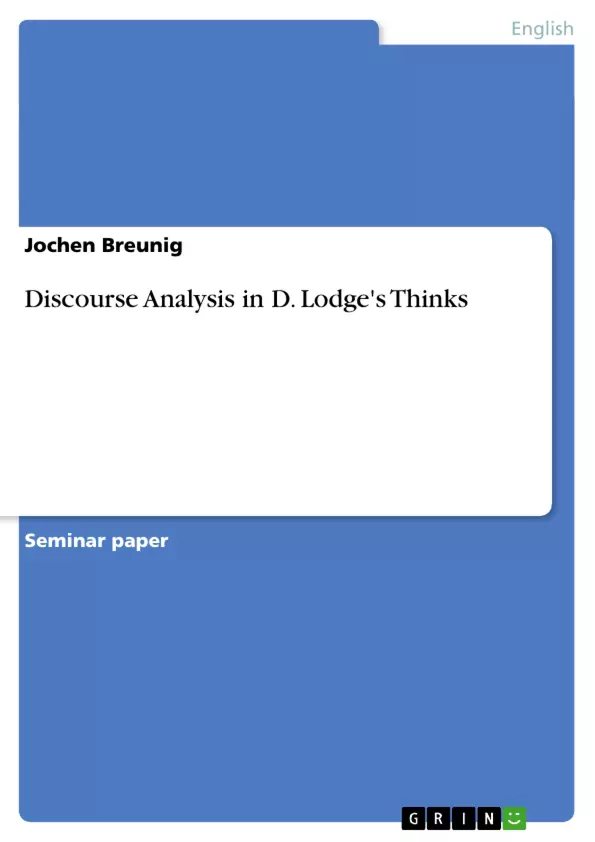Text linguistic science, respectively discourse analysis, is a rather young
linguistic discipline, which was mainly established in the 1960s and 70s. It mainly
emerged from three linguistic movements: rhetoric, stylistics and structural analysis
of narratives.
Discourse analysis tries to figure out specific schemes which are relevant to
define a chain of words as a text. As there have always been different definitions of
what a text is it is absolutely necessary in this paper which definition is actually
used. However, it has to be said that there is still no one and only valid definition of
what a text is.
Thus, the beginning of the paper deals with several theoretical subjects and
explains the term “text” that is relevant for the following analysis. Besides, it
describes which criteria have to be fulfilled in order to achieve textuality.
In the course of the analysis the paper applies the introduced text theory to
an excerpt of David Lodge’s novel "Thinks..." which was published in 2001. The
excerpt’s textuality is examined by illustrating how far the seven criteria of
textuality are fulfilled. This novel was chosen because it combines many different
ways of telling. The analyzed extract, for example, is a stream of consciousness and
contains many peculiarities. Therefore, it is very interesting to figure out if the
passage can be defined as a text without problems.
Furthermore, this paper analyzes the relevant peculiarities in the text’s
structure and in its syntax. In the course of this analysis, again, several necessary
theoretical aspects are explained. Furthermore, the text type is named.
As there are no peculiarities in the text’s sound structure and as sign theory
does not play a role these two points are not taken into consideration. At the end
some concluding remarks sum up the text analysis’s most important results. [...]
Inhaltsverzeichnis (Table of Contents)
- Introduction
- Matter of Analysis
- Textuality
- Definition of "Text"
- Seven Criteria of Textuality
- Reference
- Deixis
- Pronouns
- Connotation & Denotation
- Text Structure & Syntax
- Thematic Progression
- Syntactic Peculiarities
- Text Type
Zielsetzung und Themenschwerpunkte (Objectives and Key Themes)
This paper analyzes a passage from David Lodge's novel Thinks... to determine its textuality according to the seven criteria of textuality. The paper explores how the concept of "text" is defined in text linguistics, how it applies to Lodge's novel, and how the extract fulfills the criteria of textuality. The analysis examines the specific characteristics of the text's structure and syntax, providing insights into the linguistic features that contribute to its overall meaning.
- Defining "text" in text linguistics
- Applying textuality criteria to a specific literary extract
- Analyzing the text's structure and syntax
- Determining the text type
- Identifying the text's unique features and their impact on meaning
Zusammenfassung der Kapitel (Chapter Summaries)
The introduction presents the background of text linguistics and discourse analysis, highlighting the origins of the discipline and the importance of defining "text". The analysis focuses on the excerpt from Thinks..., which combines different narrative perspectives and features a stream of consciousness. The passage's unique features, such as its jumps in thought and the use of ellipses, are discussed in relation to textuality. The chapter examines the criteria for textuality, particularly the seven criteria of DeBeaugrande and Dressler, as they apply to the analyzed passage.
Schlüsselwörter (Keywords)
Text linguistics, discourse analysis, textuality, criteria of textuality, stream of consciousness, interior monologue, David Lodge, Thinks..., narrative perspective, literary analysis, text structure, syntax, text type.
- Quote paper
- Jochen Breunig (Author), 2002, Discourse Analysis in D. Lodge's Thinks, Munich, GRIN Verlag, https://www.hausarbeiten.de/document/7207


